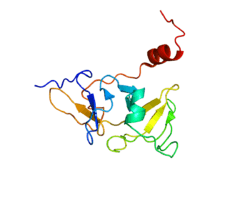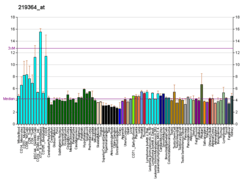LGP2
Probable ATP-dependent RNA helicase DHX58 also known as RIG-I-like receptor 3 (RLR-3) or RIG-I-like receptor LGP2 (RLR) is a RIG-I-like receptor dsRNA helicase enzyme that in humans is encoded by the DHX58 gene.[5][6] The protein encoded by the gene DHX58 is known as LGP2 (Laboratory of Genetics and Physiology 2).[5][7][8]
Structure and function
LGP2 was first identified and characterized in the context of mammary tissue in 2001,[5] but its function has been found to be more relevant to the field of innate antiviral immunity. LGP2 has been found to be essential for producing effective antiviral responses against many viruses that are recognized by RIG-I and MDA5.[9]
Since LGP2 lacks CARD domains, its effect on downstream antiviral signaling is likely due to interaction with dsRNA viral ligand or the other RLRs (RIG-I and MDA5).[10]
LGP2 has been shown to directly interact[10] with RIG-I through its C-terminal repressor domain (RD). The primary contact sites in this interaction is likely between the RD of LGP2 and the CARD or helicase domain of RIG-I as it is seen with RIG-I self-association,[10] but this has not been confirmed. The helicase activity of LGP2 has been found to be essential for its positive regulation of RIG-I signaling.[9] Overexpression of LGP2 is able to inhibit RIG-I-mediated antiviral signaling both in the presence and absence of viral ligands.[10][11][12] This inhibition of RIG-I signaling is not dependent upon the ability of LGP2 to bind viral ligands and is therefore not due to ligand competition.[7][13] Although LGP2 binds to dsRNA with higher affinity,[12] it is dispensable for RIG-I-mediated recognition of synthetic dsRNA ligands.[9] RIG-I, when overexpressed[7] and in LGP2 knock-down studies,[14] has been shown to induce antiviral response in the absence of viral ligand.
References
- GRCh38: Ensembl release 89: ENSG00000108771 - Ensembl, May 2017
- GRCm38: Ensembl release 89: ENSMUSG00000017830 - Ensembl, May 2017
- "Human PubMed Reference:". National Center for Biotechnology Information, U.S. National Library of Medicine.
- "Mouse PubMed Reference:". National Center for Biotechnology Information, U.S. National Library of Medicine.
- Cui Y, Li M, Walton KD, Sun K, Hanover JA, Furth PA, Hennighausen L (Dec 2001). "The Stat3/5 locus encodes novel endoplasmic reticulum and helicase-like proteins that are preferentially expressed in normal and neoplastic mammary tissue". Genomics. 78 (3): 129–34. doi:10.1006/geno.2001.6661. PMID 11735219.
- "Entrez Gene: LGP2 likely ortholog of mouse D11lgp2".
- Childs K, Randall R, Goodbourn S (April 2012). "Paramyxovirus V proteins interact with the RNA Helicase LGP2 to inhibit RIG-I-dependent interferon induction". J. Virol. 86 (7): 3411–21. doi:10.1128/JVI.06405-11. PMC 3302505. PMID 22301134.
- Matsumiya T, Stafforini DM (2010). "Function and regulation of retinoic acid-inducible gene-I". Crit. Rev. Immunol. 30 (6): 489–513. doi:10.1615/critrevimmunol.v30.i6.10. PMC 3099591. PMID 21175414.
- Satoh T, Kato H, Kumagai Y, Yoneyama M, Sato S, Matsushita K, Tsujimura T, Fujita T, Akira S, Takeuchi O (January 2010). "LGP2 is a positive regulator of RIG-I- and MDA5-mediated antiviral responses". Proc. Natl. Acad. Sci. U.S.A. 107 (4): 1512–7. doi:10.1073/pnas.0912986107. PMC 2824407. PMID 20080593.
- Saito T, Hirai R, Loo YM, Owen D, Johnson CL, Sinha SC, Akira S, Fujita T, Gale M (January 2007). "Regulation of innate antiviral defenses through a shared repressor domain in RIG-I and LGP2". Proc. Natl. Acad. Sci. U.S.A. 104 (2): 582–7. doi:10.1073/pnas.0606699104. PMC 1766428. PMID 17190814.
- Rothenfusser S, Goutagny N, DiPerna G, Gong M, Monks BG, Schoenemeyer A, Yamamoto M, Akira S, Fitzgerald KA (October 2005). "The RNA helicase Lgp2 inhibits TLR-independent sensing of viral replication by retinoic acid-inducible gene-I". J. Immunol. 175 (8): 5260–8. doi:10.4049/jimmunol.175.8.5260. PMID 16210631.
- Yoneyama M, Kikuchi M, Matsumoto K, Imaizumi T, Miyagishi M, Taira K, Foy E, Loo YM, Gale M, Akira S, Yonehara S, Kato A, Fujita T (September 2005). "Shared and unique functions of the DExD/H-box helicases RIG-I, MDA5, and LGP2 in antiviral innate immunity". J. Immunol. 175 (5): 2851–8. doi:10.4049/jimmunol.175.5.2851. PMID 16116171.
- Wang Y, Ludwig J, Schuberth C, Goldeck M, Schlee M, Li H, Juranek S, Sheng G, Micura R, Tuschl T, Hartmann G, Patel DJ (July 2010). "Structural and functional insights into 5'-ppp RNA pattern recognition by the innate immune receptor RIG-I". Nat. Struct. Mol. Biol. 17 (7): 781–7. doi:10.1038/nsmb.1863. PMC 3744876. PMID 20581823.
- Burel SA, Machemer T, Ragone FL, Kato H, Cauntay P, Greenlee S, Salim A, Gaarde WA, Hung G, Peralta R, Freier SM, Henry SP (July 2012). "Unique O-Methoxyethyl Ribose-DNA Chimeric Oligonucleotide Induces an Atypical Melanoma Differentiation-Associated Gene 5-Dependent Induction of Type I Interferon Response". J. Pharmacol. Exp. Ther. 342 (1): 150–62. doi:10.1124/jpet.112.193789. PMID 22505629.
Further reading
- Maruyama K, Sugano S (1994). "Oligo-capping: a simple method to replace the cap structure of eukaryotic mRNAs with oligoribonucleotides". Gene. 138 (1–2): 171–4. doi:10.1016/0378-1119(94)90802-8. PMID 8125298.
- Bonaldo MF, Lennon G, Soares MB (1997). "Normalization and subtraction: two approaches to facilitate gene discovery". Genome Res. 6 (9): 791–806. doi:10.1101/gr.6.9.791. PMID 8889548.
- Suzuki Y, Yoshitomo-Nakagawa K, Maruyama K, et al. (1997). "Construction and characterization of a full length-enriched and a 5'-end-enriched cDNA library". Gene. 200 (1–2): 149–56. doi:10.1016/S0378-1119(97)00411-3. PMID 9373149.
- Strausberg RL, Feingold EA, Grouse LH, et al. (2003). "Generation and initial analysis of more than 15,000 full-length human and mouse cDNA sequences". Proc. Natl. Acad. Sci. U.S.A. 99 (26): 16899–903. doi:10.1073/pnas.242603899. PMC 139241. PMID 12477932.
- Ota T, Suzuki Y, Nishikawa T, et al. (2004). "Complete sequencing and characterization of 21,243 full-length human cDNAs". Nat. Genet. 36 (1): 40–5. doi:10.1038/ng1285. PMID 14702039.
- Rual JF, Venkatesan K, Hao T, et al. (2005). "Towards a proteome-scale map of the human protein-protein interaction network". Nature. 437 (7062): 1173–8. doi:10.1038/nature04209. PMID 16189514.
- Komuro A, Horvath CM (2007). "RNA- and virus-independent inhibition of antiviral signaling by RNA helicase LGP2". J. Virol. 80 (24): 12332–42. doi:10.1128/JVI.01325-06. PMC 1676302. PMID 17020950.





